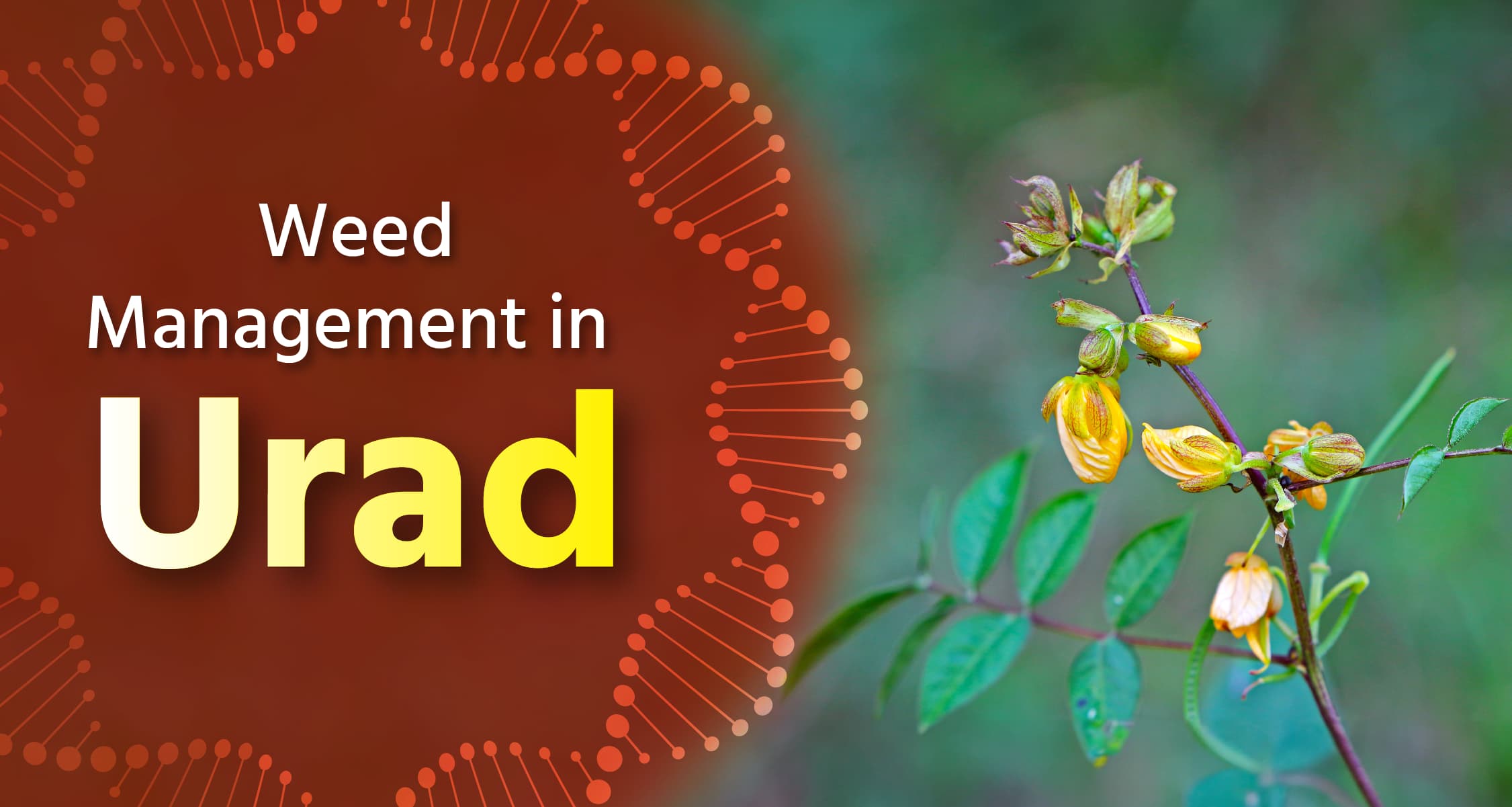Weed Management in Urad

It is very much necessary to keep the fields free from weeds for 30-35 days after sowing to achieve good yields of urad. Weeds with broad leaves such as wild amaranth, and wild jute, and narrow-leaf weeds such as Indian barnyard millet, wild sorghum, motha grass, etc. pose a significant problem in urad crops. Read this post carefully for information on controlling them.
Impact of Weeds on Urad
- Less Nutrient Availability: Weeds present in the fields absorb essential nutrients from the soil, resulting in inadequate nutrition for crops.
- Decreased Flower and Fruit Production: Overgrowth of weeds can diminish the quantity of flowers and fruits that grow on plants.
- Stunted Fruit Growth: Weeds have the potential to hinder the proper growth of the fruits, ultimately causing a reduction in fruit size.
- Increased Susceptibility to Diseases and Pests: Weeds serve as breeding grounds for various pests and fungi, which can subsequently infest the crop, leading to decreased yield and compromised quality.
- Decline in Crop Yield: Weeds inflict significant harm on primary crops, resulting in a decrease in crop yield. Consequently, farmers incur losses by selling less and low-quality produce.
- Increase in Expenditure: The utilization of herbicides/weedicides increases agricultural input expenses. Additionally, farmers resort to various pesticides and chemicals to combat pests and diseases, further adding up to the initial costs.
- Improper Supply: Given the adverse impact of weeds on crops, there's a potential risk of urad crop shortage in the market. Such a scenario could result in farmers experiencing losses rather than profits. Moreover, the scarcity in supply may cause a surge in their prices.
Controlling Weeds by Chemical Inputs
- Before sowing, use 600 ml Fluchloralin 45% EC (Basalin) per acre of field.
- Use 1,200 ml Pendimethalin 30% EC (UPL Dost, Sulphur Mills Pendisul) per acre of field before germination of urad.
- 15-20 days after sowing of urad, spray 300-400 ml of Quizalofop Ethyl 5% EC (Dhanuka Targa Super) mixed in 200 liters of water per acre of field.
Some Other Methods to Control Weeds
Deep Plowing
- For optimal field preparation before sowing, consider deep plowing to effectively eliminate existing weeds.
- Additionally, you have the option to plow and mix the weeds into the soil as green manure. This dual approach not only eradicates weeds but also enriches the soil with essential nutrients, fostering healthier crop growth.
Distance Between Crops
- Take special care of distance while sowing seeds or transplanting plants.
- If the distance is more than required, weeds get space to grow.
Weeding
- Weeding is a major technique that can be helpful in controlling weeds.
- After sowing, the first weeding can be done after 20 to 25 days.
- Subsequently, this process can be repeated as per requirement.
- Weeding ensures that the crop is well nourished and helps in reducing weeds.
Crop Rotation
- Adopt crop rotation cultivation to control weeds.
- Planting different crops according to season in the field can disrupt the life cycle of weeds.
- This reduces the problem of weeds substantially.
Factors to Consider While Applying Herbicides/Weedicides
It is crucial to take into account several key factors when applying herbicides or weedicides.
- Adequate soil moisture is essential for ensuring adequate infiltration of the chemicals to reach the crop effectively during herbicide/weedicide application.
- Application of herbicides/weedicides is best done in the morning or evening.
- During spraying, it is important to use the correct quantity of herbicide/weedicide to avoid any adverse effects on the crop.
- Mixing herbicides with insecticides, pesticides, or fungicides should be avoided as it can decrease the efficacy of the herbicides.
What methods do you use to control weeds in the urad crop? Share your answers with us in the comments. If you find the information provided in this post useful, don't forget to like and share it. For more information on weed control, follow the 'Weed Management' channel now. Also, to get proper advice on weed management from agri-experts, you can contact DeHaat's toll-free number - 1800-1036-110.
Frequently Asked Questions (FAQs)
Q: What are the various approaches to managing weed growth?
A: Various approaches are carried out to manage weeds in agriculture. These encompass traditional techniques, tool-dependent methods, and chemical interventions such as weedicides or herbicides, alongside biological input options. Traditional practices incorporate strategies like crop rotation, intercropping, and mulching to suppress weed outbreaks. Tool-based methods involve manual removal and mowing of weeds. Chemical interventions utilize herbicides or weedicides for weed eradication. Additionally, organic inputs can also be utilized for weed control.
Q: Which is the best weedicide/herbicide for controlling weeds?
A: There are several types of chemical inputs available in the market for weed control. Different weedicides/herbicides are used for different crops. Additionally, there are separate chemical inputs for broad-leaf and narrow-leaf weeds. Therefore, always use the chemical inputs according to the crops you are cultivating.
Q: How do you prevent weeds from growing in fields?
A: To prevent weeds from growing in the field, do deep plowing before planting the crop. This will destroy the weeds already present in the field. Select high-quality seeds for sowing. Clean the seeds thoroughly before sowing. Make sure that there are no weed seeds along with the crop seeds. Mulching in the fields also relieves this problem. Apart from this, we can also avoid this problem by using chemical weedicide within 2 days after sowing.
Please login to continue

Get free advice from a crop doctor
